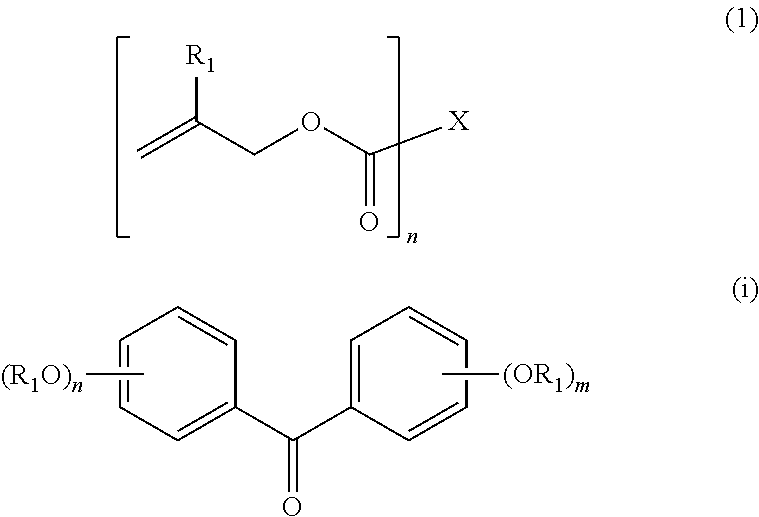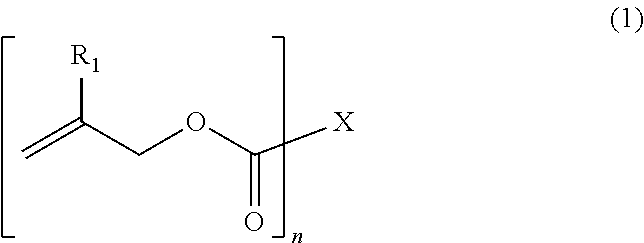Polymerizable composition for optical material and optical material and plastic lens obtained from same composition
a technology of optical materials and polymerizable compositions, applied in the field of polymerizable compositions for optical materials and optical materials and plastic lenses obtained from same compositions, can solve problems such as eye fatigue and pain, eye strain and stress, and adverse effects of ultraviolet light exposure on eyes, and achieve excellent optical properties, reduce the influence of harmful light on eyes, and superior blocking effect of ligh
- Summary
- Abstract
- Description
- Claims
- Application Information
AI Technical Summary
Benefits of technology
Problems solved by technology
Method used
Image
Examples
example 1
[0300]Uvinul 3049 (manufactured by BASF) 1.5 parts by weight, Macrolex Blue RR (manufactured by Lanxess) 6 ppm, and Solvaperm Red Violet R (manufactured by Clariant) 6 ppm were dissolved at 70° C. with respect to RAV 7MC (manufactured by Acomon) 99.2 parts by weight and cooled to room temperature, then Luperox Taec (manufactured by Arkema) 0.8 parts by weight was added thereto as a radical polymerization initiator and the resultant was injected into a mold in which the outer periphery of two disc-shaped glass plates was wrapped with an adhesive tape, and polymerized for 24 hours while gradually raising the temperature from room temperature to 120° C. Thereafter, the polymerizable composition was released from the mold and heated at 120° C. for 1 hour to carry out post-polymerization to obtain a flat plate having a thickness of 2 mm. The obtained resin flat plate cut the light rays of 420 run by approximately 80%, the hue was good, and the transparency was high.
example 2
[0301]Uvinul 3049 (manufactured by BASF) 1.5 parts by weight, Macrolex Blue RR (manufactured by Lanxess) 6 ppm, and Solvaperm Red Violet R (manufactured by Clariant) 6 ppm were dissolved at 70° C. with respect to RAV 7MC (manufactured by Acomon) 98.0 parts by weight and cooled to room temperature, then Trigonox 29-C75 (manufactured by AkzoNobel) 2.0 parts by weight was added thereto as a radical polymerization initiator and the resultant was injected into a mold in which the outer periphery of two disc-shaped glass plates was wrapped with an adhesive tape, and polymerized for 25 hours while gradually raising the temperature from room temperature to 110° C. Thereafter, the polymerizable composition was released from the mold and heated at 120° C. for 1 hour to carry out post-polymerization to obtain a flat plate having a thickness of 2 mm. The obtained resin flat plate cut the light rays of 420 nm by approximately 80%, the hue was good, and the transparency was high.
example 3
[0302]Uvinul 3049 (manufactured by BASF) 1.5 parts by weight, Plast Blue 8520 (manufactured by Arimoto Chemical Co., Ltd.) 6.25 ppm, and Solvaperm Red Violet R (manufactured by Clariant) 3 ppm were dissolved at 70° C. with respect to RAV 7MC (manufactured by Acomon) 99.2 parts by weight and cooled to room temperature, then Luperox 531M80 (manufactured by Arkema Yoshitomi, Ltd.) 0.8 parts by weight was added thereto as a radical polymerization initiator and the resultant was injected into a mold in which the outer periphery of two disc-shaped glass plates was wrapped with an adhesive tape, and polymerized for 21 hours while gradually raising the temperature from room temperature to 110° C. Thereafter, the polymerizable composition was released from the mold and heated at 120° C. for 2 hours to carry out post-polymerization to obtain a flat plate having a thickness of 2 mm. The obtained resin flat plate cut the light rays of 420 nm by approximately 80%, the hue was good, and the trans...
PUM
| Property | Measurement | Unit |
|---|---|---|
| half-life temperature | aaaaa | aaaaa |
| half-life temperature | aaaaa | aaaaa |
| wavelength | aaaaa | aaaaa |
Abstract
Description
Claims
Application Information
 Login to View More
Login to View More - R&D
- Intellectual Property
- Life Sciences
- Materials
- Tech Scout
- Unparalleled Data Quality
- Higher Quality Content
- 60% Fewer Hallucinations
Browse by: Latest US Patents, China's latest patents, Technical Efficacy Thesaurus, Application Domain, Technology Topic, Popular Technical Reports.
© 2025 PatSnap. All rights reserved.Legal|Privacy policy|Modern Slavery Act Transparency Statement|Sitemap|About US| Contact US: help@patsnap.com



